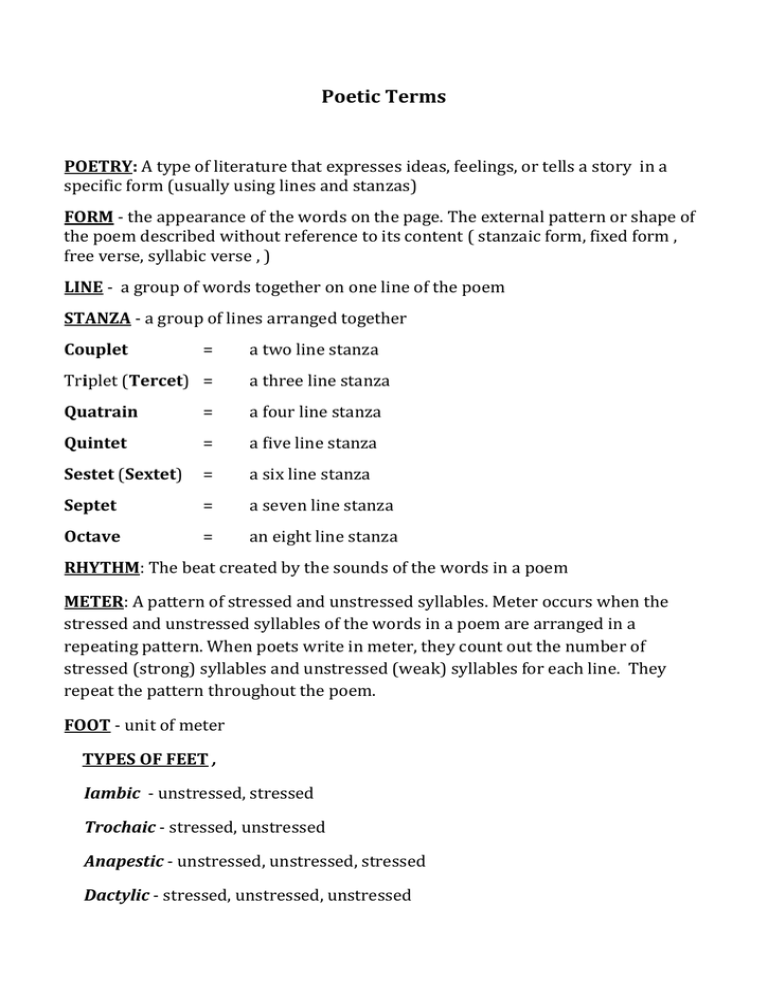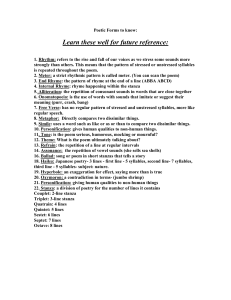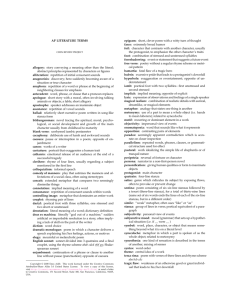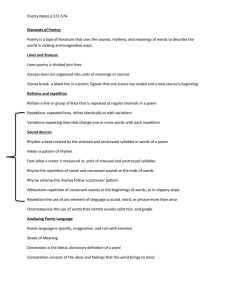Poetic Terms
advertisement

Poetic Terms POETRY: A type of literature that expresses ideas, feelings, or tells a story in a specific form (usually using lines and stanzas) FORM - the appearance of the words on the page. The external pattern or shape of the poem described without reference to its content ( stanzaic form, fixed form , free verse, syllabic verse , ) LINE - a group of words together on one line of the poem STANZA - a group of lines arranged together Couplet = a two line stanza Triplet (Tercet) = a three line stanza Quatrain = a four line stanza Quintet = a five line stanza Sestet (Sextet) = a six line stanza Septet = a seven line stanza Octave = an eight line stanza RHYTHM: The beat created by the sounds of the words in a poem METER: A pattern of stressed and unstressed syllables. Meter occurs when the stressed and unstressed syllables of the words in a poem are arranged in a repeating pattern. When poets write in meter, they count out the number of stressed (strong) syllables and unstressed (weak) syllables for each line. They repeat the pattern throughout the poem. FOOT - unit of meter TYPES OF FEET , Iambic - unstressed, stressed Trochaic - stressed, unstressed Anapestic - unstressed, unstressed, stressed Dactylic - stressed, unstressed, unstressed Kinds of Metrical Lines monometer = one foot on a line dimeter = two feet on a line trimeter = three feet on a line tetrameter = four feet on a line pentameter = five feet on a line hexameter = six feet on a line heptameter = seven feet on a line octometer = eight feet on a line RHYME SCHEMEA: rhyme scheme is a pattern of rhyme (usually end rhyme, but not always). Use the letters of the alphabet to represent sounds to be able to visually “see” the pattern. ONOMATOPOEI: Words that imitate the sound they are naming, BUZZ ALLITERATION: Consonant sounds repeated at the beginnings of words If Peter Piper picked a peck of pickled peppers, how many pickled peppers did Peter Piper pick? CONSONANCE: Similar to alliteration EXCEPT . . . The repeated consonant sounds can be anywhere in the words “silken, sad, uncertain, rustling . . “ ASSONANCE: Repeated VOWEL sounds in a line or lines of poetry. (Often creates near rhyme.) Fade Base Fate Lake (All share the long “a” sound.) REFRAIN: A sound, word, phrase or line repeated regularly in a poem LYRIC: A short poem Usually written in first person point of view Expresses an emotion or an idea or describes a scene Do not tell a story and are often musical SHAKESPEAREAN SONNET A fourteen line poem with a specific rhyme scheme. The poem is written in three quatrains and ends with a couplet. The rhyme scheme is abab cdcd efef gg SIMILE: A comparison of two things using “like, as than,” or “resembles.” “She is as beautiful as a sunrise.” METAPHOR: A direct comparison of two unlike things “All the world’s a stage, and we are merely players.” EXTENDED METAPHOR: A metaphor that goes several lines or possible the entire length of a work. IMPLIED METAPHOR: The comparison is hinted at but not clearly stated. HYPERBOLE: Exaggeration often used for emphasis. PERSONIFICATION: An animal given human-like qualities or an object given life-like qualities SYMBOLISM: When a person, place, thing, or event that has meaning in itself also represents, or stands for, something else. IMAGERY: Language that appeals to the senses. Most images are visual, but they can also appeal to the senses of sound, touch, taste, or smell. ALLEGORY: A story in which the characters represent abstract qualities or ideas. Couplets: A pair of rhyming lines in a poem often set off from the rest of the poem. Shakespeare’s sonnets all end in couplets. Figurative Language: Language that does not mean exactly what it says. For example, you can call someone who is very angry “steaming.” Unless steam was actually coming out of your ears, you were using figurative language. Irony: Language that conveys a certain ideas by saying just he opposite.





